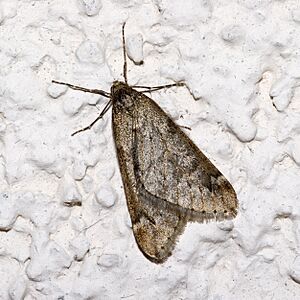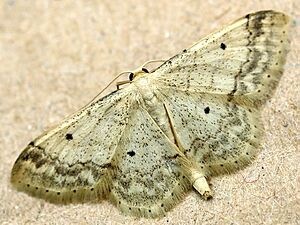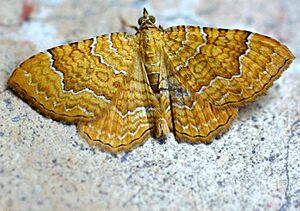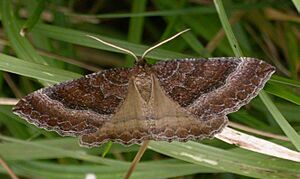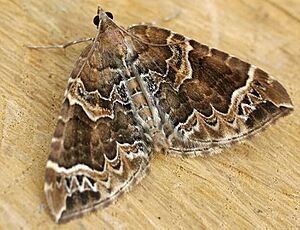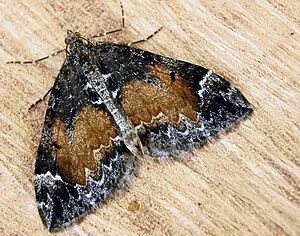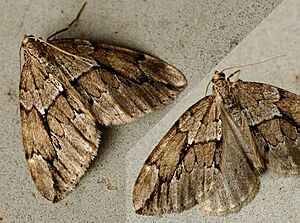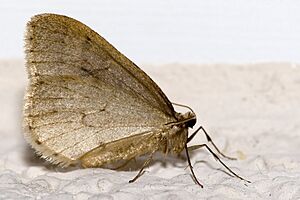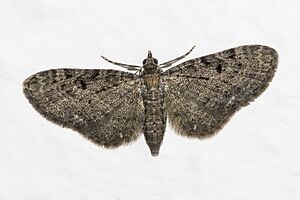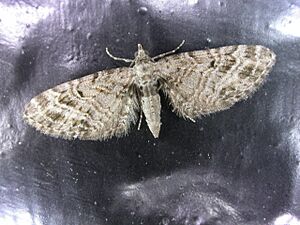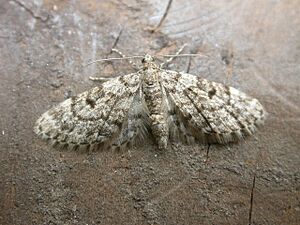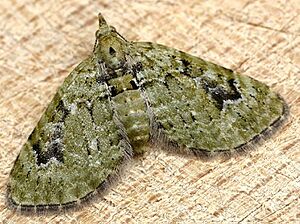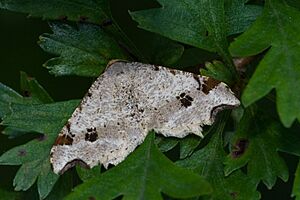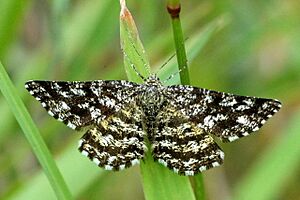List of moths of Great Britain (Geometridae) facts for kids
The family Geometridae is a huge group of moths, with over 300 different kinds found in Great Britain. These moths are often called "loopers" or "inchworms" because of how their caterpillars move. Instead of crawling smoothly, they arch their bodies into a loop, then stretch forward, like they're measuring the ground!
Contents
Meet the Geometrid Moths!
Scientists group living things into families and subfamilies to help understand them better. The Geometridae family is divided into several subfamilies, each with its own unique moths. Let's explore some of them!
Archiearinae: The Early Fliers
This small subfamily includes moths that often fly early in the year.
- Archiearis parthenias, the orange underwing moth, can be found in many places, but often in specific areas.
- Archiearis notha, the light orange underwing, is less common and mostly seen in the south.
Alsophilinae: The March Moth
This subfamily has just one main species in Great Britain.
- Alsophila aescularia, known as the March moth, is found all over the country. It's one of the first moths you might see in spring!
Geometrinae: The Emeralds
Many moths in this subfamily have beautiful green colors, like jewels!
- Pseudoterpna pruinata atropunctaria, the grass emerald, is found everywhere.
- Geometra papilionaria, the large emerald, is another common green moth.
- Hemithea aestivaria, the common emerald, lives in the south and central parts of the country.
- Some emerald moths are quite rare. For example, Aplasta ononaria, the rest harrow, and Thalera fimbrialis, the Sussex emerald, are both listed in the Red Data Book, meaning they are endangered.
- Sadly, Antonechloris smaragdaria maritima, the Essex emerald, is thought to be extinct in Great Britain.
Sterrhinae: The Waves and Mochas
This subfamily has many moths with names like "wave" or "mocha," often referring to patterns on their wings.
- Cyclophora punctaria, the maiden's blush, is found in the south and central areas.
- Timandra comai, the blood-vein, has a distinctive red line on its wings. It's considered vulnerable.
- Scopula imitaria, the small blood-vein, is another common moth in the south and central regions.
- Some moths in this group are very rare, like Scopula immorata, the Lewes wave, which is probably extinct.
- Idaea biselata, the small fan-footed wave, can be found all over.
- Idaea seriata, the small dusty wave, is found in the south, central, and north-east.
- Rhodometra sacraria, the Vestal, is an immigrant moth, meaning it flies to Great Britain from other countries.
Larentiinae: Carpets and Pugs
This is a very large subfamily, with many moths known as "carpets" or "pugs" because of their patterns or small size.
- Orthonama vittata, the oblique carpet, is found throughout Great Britain.
- Xanthorhoe fluctuata fluctuata, the garden carpet, is a very common moth you might see in your garden.
- Camptogramma bilineata, the yellow shell, is another widespread moth.
- Larentia clavaria, the mallow, is found in the south, central, and north.
- Eulithis prunata, the phoenix, is found all over the country.
- Chloroclysta truncata, the common marbled carpet, is also found everywhere.
- Thera juniperata, the juniper carpet, lives where juniper plants grow.
- Operophtera brumata, the winter moth, is active even in colder months.
- Perizoma alchemillata, the small rivulet, is found throughout Great Britain.
- The "pug" moths are a large group within this subfamily, known for being small and often having subtle patterns.
- Eupithecia virgaureata, the golden-rod pug, is found in the west and east.
- Eupithecia dodoneata, the oak-tree pug, lives in the south and central areas.
- Eupithecia tantillaria, the dwarf pug, is found all over.
- Chloroclystis v-ata, the v-pug, gets its name from a V-shaped mark on its wings. It's found everywhere.
- Chesias legatella, the streak, and Chesias rufata, the broom-tip, are both considered vulnerable.
- Abraxas grossulariata, the magpie moth, has a striking black and white pattern. It's found throughout the country.
- Macaria alternata, the sharp-angled peacock, lives in the south and central areas.
- Plagodis dolabraria, the scorched wing, is found throughout.
- Biston betularia, the peppered moth, is famous for its color changes during the Industrial Revolution. It's found everywhere.
- Ematurga atomaria, the common heath, is found all over.
- Campaea margaritata, the light emerald, is another beautiful green moth found throughout Great Britain.
Conservation Status
Some moths in this list have special symbols next to their names.
- A double-dagger (‡) means the species is listed in the UK Biodiversity Action Plan (BAP). This plan helps protect species that are rare or at risk.
- An asterisk (‡*) means the species is listed in the BAP for research purposes.
- "Red Data Book" means the species is endangered or critically endangered.
- "Nationally Scarce A" means it's found in 30 or fewer areas in Great Britain.
- "Nationally Scarce B" means it's found in 31-100 areas.
- "Vulnerable" means it's at high risk of extinction.
- "Endangered" means it's at very high risk of extinction.
- "Extinct" means it no longer exists in Great Britain.
- "Immigrant" means it flies to Great Britain from other countries and doesn't usually live there permanently.
It's important to protect these amazing moths and their habitats so they can continue to thrive!
See also
- List of moths of Great Britain (overview)
- Family lists: Hepialidae, Cossidae, Zygaenidae, Limacodidae, Sesiidae, Lasiocampidae, Saturniidae, Endromidae, Drepanidae, Thyatiridae, Geometridae, Sphingidae, Notodontidae, Thaumetopoeidae, Lymantriidae, Arctiidae, Ctenuchidae, Nolidae, Noctuidae and Micromoths


